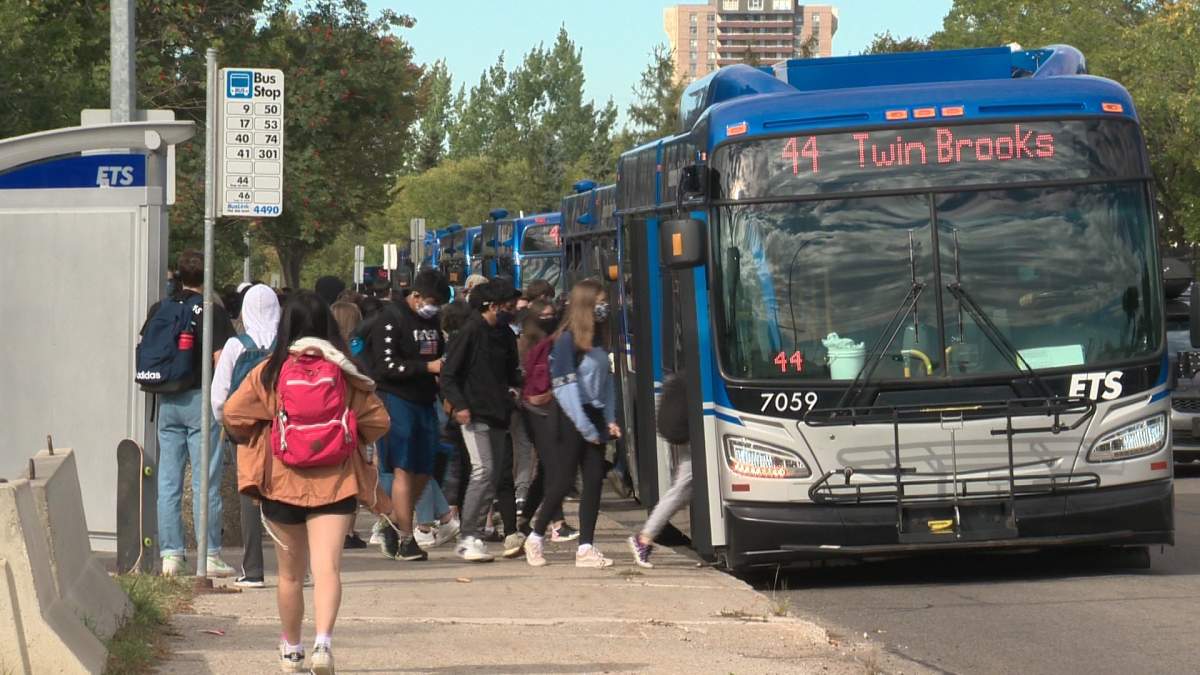As more people head back to school and work this fall, ridership on the Edmonton Transit Service is slowly returning to normal. However, with that has come some overcrowding issues on frequently used bus routes.

Full ETS service resumed on Aug. 30, after it was reduced in mid-March amid the COVID-19 pandemic. Ridership dropped to about 25 per cent of regular capacity in April, but has slowly started to climb back up.
On Tuesday morning, Eddie Robar, branch manager of ETS, said ridership is currently sitting at about 50 per cent of pre-COVID levels.
“We’re starting to see a gradual return to transit,” he explained.
“ETS is showing good results in gaining ridership and we’re seeing that happen week over week as school resumes and people get back to work.”
But as more kids head back to school, Robar acknowledged that the service is seeing some overcrowding on popular routes during peak hours. He said they are monitoring and tweaking service, and support buses will be brought in as needed, but he added that there are some challenges with that.
“We have 100 per cent of our service up and 50 per cent of our passengers… There are some localized issues and we’re looking at support buses to support that service,” he said. “But there’s not a windfall of buses when we’re at 100 per cent of service.
“Our ask is that people take that into account and look at other alternatives, maybe skip that bus and take the next bus.”
Another challenge being faced on the transit system is physical distancing. While two metres of social distance is encouraged, Robar said maintaining social distance on all routes “is going to be a challenge.” He said the ETS continues to push education around mask use.
Masks have been mandatory on public transit since Aug. 1. As of Sept. 14, mask/face covering compliance was 98 per cent on buses and 88 per cent on LRT, according to the city.

Get daily National news
“I rode the LRT last week and was pleased to see that just about everybody was wearing a mask. It’s important that we help keep each other safe and follow provincial guidelines,” Robar added.
According to one infectious disease specialist with the University of Alberta, public transit has not so far proven to be a high risk for COVID-19 transmission. However, she points to specific circumstances that should be taken into account, including how long you’re next to people, air circulation and whether transit users are wearing masks.
“Anytime we see a group of people packed together, that raises some alarm bells,” Dr. Lynora Saxinger said.
“If it’s a very short ride, you expect the risk to be less than a long ride. And of course if your community doesn’t really have any COVID right now, the risk of any individual person on a bus having COVID would be less.
“But if there’s a lot of community transmission, and we know there’s transmission in that age range, then I think you’d have greater concern.”
Saxinger said opening bus windows is beneficial, as well as mask-wearing.
“Most of the studies that would actually tend to support the use of cloth masks mostly point to the fact that they are effective at reducing the droplets that happen when people cough, sneeze, speak loudly… So that seems like a worthwhile goal in this setting as well.”

New payment methods for Ride Transit Program participants
Due to COVID-19, most city-operated facilities remain closed for in-person Ride Transit Program pass sales. But starting this week, new payment options will be available for program participants.
Program participants are now able to purchase transit passes online 24 hours a day, seven days a week. Right now, credit card is the only payment option, but Robar said work is underway to implement VISA Debit and Debit Mastercard payment options as soon as possible.
Users can also order their monthly passes over the phone by calling 780-423-RIDE. The phone line is open Monday to Friday from 8 a.m. to 4:30 p.m.
Those who use the online or phone payment options will have their passes mailed to them.
People can also set up an appointment to purchase their pass in-person at one of four city recreation centres. However, Robar said the city is trying to limit in-person interaction due to the COVID-19 pandemic. Those who wish to pay for their pass in person can call 780-423-RIDE to set up an appointment.
Robar said the city also has an automatic debit withdrawal payment option for people to purchase their November passes. An automatic withdrawal would come out of the transit user’s bank account a few weeks before the applicable month. Passes are then mailed out to users.
The option has been available to AISH users for years, Robar said.
“This option here is probably going to be the easiest for folks,” he said. “Looking at that option for November is a really good option.”
While it won’t be ready in time for the purchase of October passes, the city encourages anyone interested in the auto-debit withdrawal option for November and future monthly passes to sign up by Sept. 21.
Robar acknowledged the new payment options are rolling out quickly and asked for patience from users.
A spokesperson with the ETS said when comparing August fare revenues, 2020 saw an overall decrease of about $5.1 million compared to 2019.
“In September, transit revenues and ridership typically increase as students return to school and people resume their normal activities after summer vacations. We are monitoring sales figures closely and expect to see an increase in the coming months,” Rowan Anderson said.
More information about the new payment options can be found online.








Comments